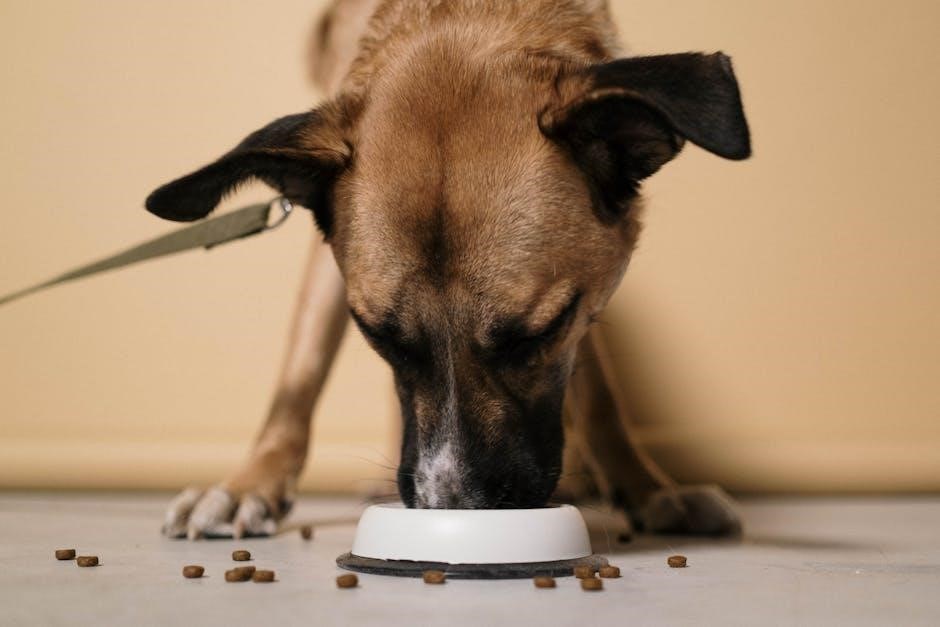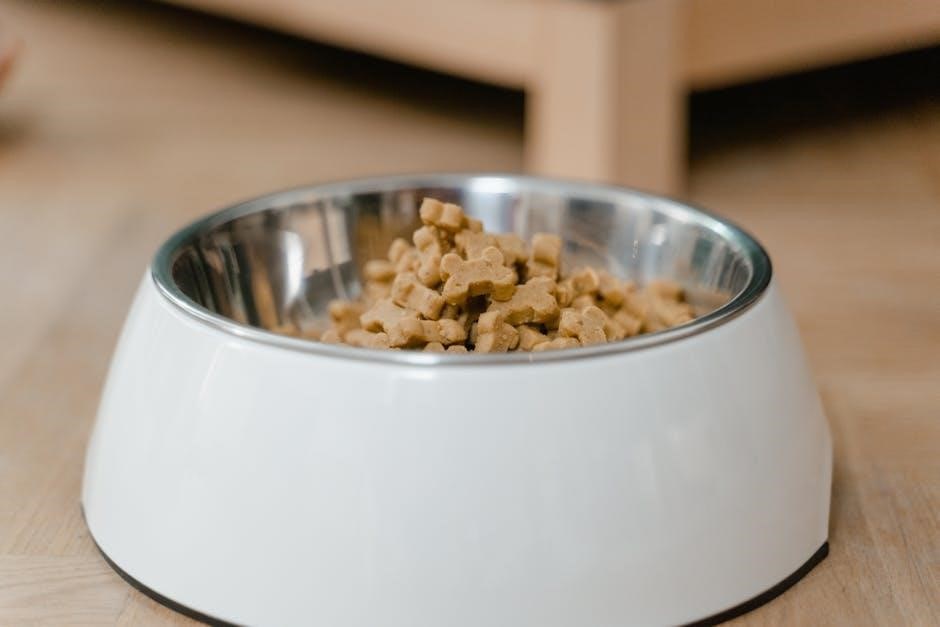Big Dog Barf Feeding Guide: Addressing Vomiting
Vomiting in big dogs can be alarming․ This guide helps owners understand when it is a mild issue or a sign of something serious․ We will explore possible causes and when you need veterinary care․
Understanding Vomiting in Big Dogs
Vomiting in large breed dogs, while a common occurrence, should not be dismissed without careful consideration․ It’s crucial to recognize that vomiting is a symptom, not a disease itself, indicating an underlying issue that requires attention․ Big dogs, due to their size and sometimes sensitive digestive systems, may experience vomiting for various reasons, ranging from simple dietary indiscretions to more serious medical conditions․
Understanding the nuances of vomiting—such as frequency, appearance, and accompanying symptoms—is key to determining the appropriate course of action․ A single episode of vomiting might not warrant immediate concern and could be managed at home with a bland diet and close observation․ However, recurring vomiting, especially when coupled with other signs like lethargy, loss of appetite, or changes in stool, necessitates prompt veterinary consultation․
Recognizing the potential causes and knowing when to seek professional help can make a significant difference in your dog’s health and well-being․ This section will delve into these aspects to equip you with the knowledge to navigate this common canine concern effectively․
Common Causes of Vomiting in Large Breeds
Large breed dogs are susceptible to a variety of factors that can induce vomiting․ Dietary indiscretion, or eating something they shouldn’t, is a frequent culprit․ This includes scavenging for garbage, consuming table scraps, or ingesting spoiled food․ These actions can lead to gastrointestinal upset, triggering vomiting as the body attempts to expel the offending substances․
Infections, both bacterial and viral, can also cause vomiting in large dogs․ Gastroenteritis, an inflammation of the stomach and intestines, is a common condition resulting from such infections․ Parasites, like worms, can irritate the digestive tract, leading to vomiting and other symptoms․

Furthermore, certain medical conditions, such as pancreatitis or kidney disease, can manifest as vomiting․ Blockages in the digestive system or bloat, a life-threatening condition common in large breeds, can also cause vomiting․ Identifying the specific cause is crucial for effective treatment, highlighting the importance of veterinary diagnosis when vomiting is persistent or accompanied by other concerning symptoms․
Dietary Indiscretion as a Cause of Vomiting
Dietary indiscretion stands out as a frequent cause of vomiting in dogs, especially in larger breeds known for their scavenging tendencies․ It refers to the act of a dog consuming something outside of its regular diet that is either inappropriate, toxic, or spoiled․ This can range from raiding the garbage bin for discarded food scraps to ingesting foreign objects during walks․

The consequences of dietary indiscretion can vary depending on the substance ingested․ Spoiled food can harbor harmful bacteria, leading to gastrointestinal upset and vomiting․ Similarly, table scraps, often high in fat and seasonings, can irritate the stomach lining and trigger vomiting․ Certain toxic substances, such as chocolate or onions, can induce severe vomiting and other systemic effects․

Preventing dietary indiscretion involves careful management of the dog’s environment․ Keeping garbage cans securely covered and avoiding feeding table scraps are crucial steps․ Regular monitoring during walks can prevent the ingestion of discarded items․ If dietary indiscretion is suspected, close observation for vomiting and other symptoms is essential, and veterinary consultation is recommended if concerns arise․
Gastroenteritis and Vomiting
Gastroenteritis is a common ailment in dogs, frequently manifesting as vomiting․ It involves inflammation of the gastrointestinal tract, affecting the stomach and intestines․ This inflammation can disrupt normal digestive processes, leading to vomiting as the body attempts to expel irritants or infectious agents․ Gastroenteritis can be triggered by various factors, including sudden dietary changes, bacterial or viral infections, parasites, or ingestion of toxins․
The severity of vomiting associated with gastroenteritis can range from mild to severe, depending on the underlying cause and the dog’s overall health․ In mild cases, vomiting may be infrequent and self-limiting․ However, severe cases can involve persistent vomiting, leading to dehydration and electrolyte imbalances․ Other symptoms of gastroenteritis may include diarrhea, loss of appetite, abdominal pain, and lethargy․
Treatment for gastroenteritis typically involves addressing the symptoms and supporting the dog’s recovery․ This may include withholding food for a period to allow the digestive system to rest, followed by a bland diet of easily digestible foods․ Anti-nausea medications and fluid therapy may be administered to control vomiting and prevent dehydration․ In severe cases, antibiotics or other medications may be necessary to combat underlying infections or parasites․
Identifying Vomit Characteristics

Observing the characteristics of your dog’s vomit can provide valuable clues about the underlying cause of their illness․ Pay close attention to the color, consistency, and contents of the vomit, as these details can help your veterinarian make an accurate diagnosis․ The color of vomit can range from clear or yellow to green, brown, or even red, each potentially indicating a different issue․
The consistency of vomit can also vary, ranging from liquid to semi-solid or containing undigested food particles․ The presence of blood, mucus, or foreign objects in the vomit is also important to note․ Blood in the vomit can indicate irritation or damage to the esophagus or stomach lining, while mucus may suggest inflammation of the gastrointestinal tract․
Additionally, consider the timing of the vomiting in relation to meals․ Vomiting shortly after eating may indicate a food intolerance or rapid eating, while vomiting hours after a meal could suggest a more serious underlying condition․ By carefully observing and documenting the characteristics of your dog’s vomit, you can provide your veterinarian with valuable information to aid in their diagnosis and treatment plan․
Vomit Color and Potential Meanings

The color of your dog’s vomit can offer significant clues about the potential underlying cause of their distress․ It is important to note the color․ Clear vomit may indicate that your dog has an empty stomach, vomiting up saliva or gastric fluids․ Yellow vomit often contains bile, suggesting that the stomach is empty, and bile from the small intestine is being regurgitated․
Green vomit can suggest that your dog has ingested grass or that bile is present․ Brown vomit may indicate digested blood, which could be a sign of a more serious condition․ Red vomit suggests fresh blood, which could indicate an injury or ulcer in the esophagus or stomach․

Dark, coffee-ground-like vomit can also signify digested blood․ If you observe any of these colors in your dog’s vomit, it is crucial to consult with your veterinarian to determine the underlying cause and receive appropriate treatment․ These observations, combined with other symptoms, will help your vet diagnose your dog’s condition․
Presence of Blood or Mucus in Vomit
The presence of blood or mucus in your dog’s vomit can be a concerning sign that warrants careful observation and veterinary attention․ Blood in the vomit, known as hematemesis, can appear as bright red streaks or clots if the bleeding is fresh, indicating a potential issue in the esophagus or stomach․
Alternatively, digested blood may present as dark, coffee-ground-like material, suggesting that the bleeding has occurred higher up in the digestive tract․ Mucus in the vomit, on the other hand, often appears as a slimy, gelatinous substance․ It typically indicates inflammation or irritation of the gastrointestinal lining․
The presence of mucus can be associated with various conditions, including gastroenteritis or dietary indiscretion․ Observing the amount, color, and consistency of both blood and mucus in your dog’s vomit can provide valuable information to your veterinarian․ They can help diagnose the underlying cause of your dog’s condition․ Contact your vet as soon as possible!
When to Seek Veterinary Care

Determining when your dog’s vomiting warrants veterinary attention is crucial for their health․ While a single episode of vomiting may not be cause for alarm, certain signs indicate the need for professional medical intervention․ If your dog vomits more than once in a 24-hour period or experiences recurring bouts of vomiting, it’s essential to consult your veterinarian․
Persistent vomiting can lead to dehydration and electrolyte imbalances, especially in large breeds․ The presence of blood in the vomit, whether fresh or digested, is also a concerning sign that requires prompt veterinary evaluation․ Additionally, if your dog exhibits other symptoms alongside vomiting, such as lethargy, abdominal pain, diarrhea, or loss of appetite, it’s crucial to seek veterinary care immediately․
These symptoms may indicate a more serious underlying condition that requires diagnosis and treatment․ Timely veterinary intervention can help identify the cause of your dog’s vomiting and prevent potential complications․
Recurring Vomiting Episodes
Recurring vomiting episodes in your big dog should not be ignored․ Unlike a single instance of vomiting, repeated episodes often signal an underlying issue that requires veterinary attention․ If your dog vomits multiple times within a short period, such as a day or two, or if you notice a pattern of vomiting occurring regularly, it’s time to consult your veterinarian․

Recurring vomiting can be indicative of various conditions, including chronic gastritis, inflammatory bowel disease (IBD), or even systemic illnesses․ It’s essential to determine the root cause of the vomiting to provide appropriate treatment and prevent further complications․ Your veterinarian may recommend diagnostic tests such as blood work, fecal analysis, or imaging studies to identify the underlying problem․
Ignoring recurring vomiting episodes can lead to dehydration, malnutrition, and a decline in your dog’s overall health․ Early intervention and proper management are crucial for improving your dog’s quality of life and preventing more severe health issues․
Other Symptoms Accompanying Vomiting
When your big dog vomits, pay close attention to any other symptoms they may be exhibiting․ Vomiting rarely occurs in isolation, and accompanying symptoms can provide valuable clues about the underlying cause of the issue․ Lethargy, or a noticeable decrease in energy and activity levels, is a common sign that your dog isn’t feeling well․ Changes in appetite, such as a refusal to eat or a decreased interest in food, can also indicate a problem․
Diarrhea, either occurring alongside vomiting or shortly after, often suggests a gastrointestinal issue․ Abdominal pain, which may manifest as restlessness, whining, or a reluctance to be touched, is another concerning sign․ In more severe cases, you may observe blood in the vomit or stool, which warrants immediate veterinary attention․ Dehydration, characterized by dry gums, sunken eyes, and decreased skin elasticity, can quickly become a serious issue․
If your dog is displaying any of these additional symptoms along with vomiting, it’s crucial to seek veterinary care promptly․
Home Care for Mild Vomiting Cases

For mild cases of vomiting in big dogs, where there are no other concerning symptoms, home care can often be effective․ The first step is to withhold food for 12-24 hours to give the digestive system a chance to rest and recover․ Make sure your dog always has access to fresh, clean water to prevent dehydration․ Offer small amounts of water frequently, rather than allowing your dog to gulp down large quantities, which can trigger more vomiting․
If your dog hasn’t vomited for several hours, you can gradually reintroduce a bland diet․ Avoid giving your dog any treats, chews, or other foods that could irritate their stomach․ Observe your dog closely for any signs of recurring vomiting or other concerning symptoms․ If the vomiting persists or worsens, or if your dog develops any additional symptoms, it’s important to consult with your veterinarian for further guidance and treatment․ Remember, home care is only appropriate for mild cases with no other symptoms․
Bland Diet Recommendations for Vomiting Dogs
When reintroducing food after a vomiting episode, a bland diet is crucial for soothing your dog’s digestive system․ The goal is to provide easily digestible foods that are gentle on the stomach․ A classic bland diet consists of boiled chicken (skinless and boneless) and white rice․ The chicken provides protein, while the rice offers easily digestible carbohydrates․
Another option is lean ground turkey (cooked and drained of fat) mixed with plain cooked sweet potato․ Scrambled eggs (cooked without butter or oil) can also be a suitable protein source․ Feed small, frequent meals throughout the day, rather than large meals, to avoid overwhelming the digestive system․ Monitor your dog’s response to the bland diet․ If vomiting returns, consult your vet․ Gradually transition back to your dog’s regular diet over a few days․


